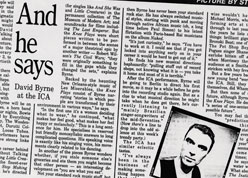ORIGINAL
PRESS CLIPPINGS

Knee Plays: Magic of the Mind
Robert Wilson has forced us to change our mind about theater. Wilson's "The Knee Plays" will be at Doolittle Theatre through Sunday night, and it is as charming an introduction to his aesthetic as can be imagined: his Five Easy Pieces.
Actually, it's 13 pieces, first intended to serve as divertissements between the sections of Wilson's mammoth, aborted epic, "the CIVIL warS." But they make sense on their own, spelling out a story that one might improvise for a child at bedtime. Once upon a time there was a man in a tree, and the tree turned into a boat, and the boat turned into a book. . . .
The story is not insisted on. It's only there if you need it. Just as real purpose of the bedtime story is to release the child into sleep, Wilson's pieces seek to quiet the viewer's codifying brain and to put him into the contemplative state of a person watching a slow sunset. The moment is the meaning-plus whatever private thoughts may ensue.
This takes time-more than five hours for Wilson's masterpiece, "Einstein on the Beach." At the Doolittle he's only got 90 minutes, the spell can't be cast as deeply as it should be.
Still, we get the idea. Wilson's theater is about the magic of the mind. Half of it we make up ourselves. His job is to provide the right cues.
The cues in "The Knee Plays" include a bare stage, often bathed in blue light; a set of white modules that will serve as tree, boat and book; a company of "dancers" in lab coats; and a startling score by David Byrne of Talking Heads.
To the eye, the piece suggests Japanese theater. The dancers move in a slow, controlled way, even when they're turning somersaults. The building and the dismantling of the boat is a ritual. Time is taken between sections. (Too much time, on opening night.) The solemnity has its droll side, but we never forget that we're watching a ceremony.
The "right" supporting music for such a piece would be light and dry, something with flutes and woodblocks. Byrne's music matches the stateliness of Suzushi Hanayagi's choreography, but its timbre is that of a gutbucket New Orleans marching band on the way to a funeral.
The contrast is so sharp that it shocks both the ear and the eye into extra attention, another hallmark of Wilson's work. Whatever his images mean, they're always drawn sharply.